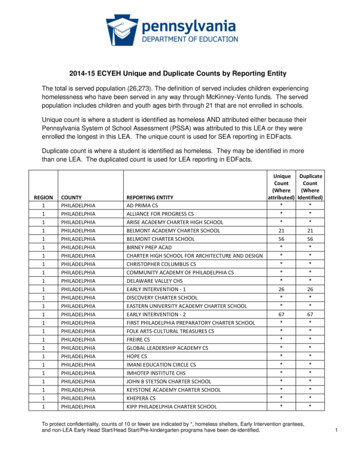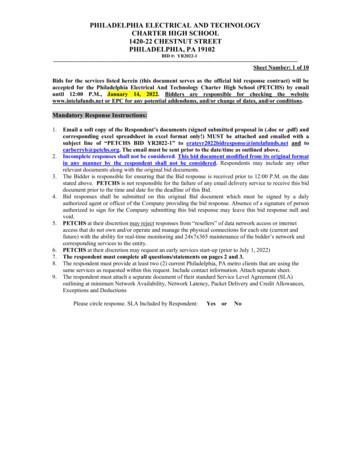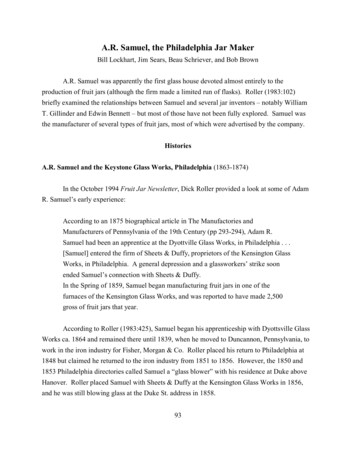
Transcription
A.R. Samuel, the Philadelphia Jar MakerBill Lockhart, Jim Sears, Beau Schriever, and Bob BrownA.R. Samuel was apparently the first glass house devoted almost entirely to theproduction of fruit jars (although the firm made a limited run of flasks). Roller (1983:102)briefly examined the relationships between Samuel and several jar inventors – notably WilliamT. Gillinder and Edwin Bennett – but most of those have not been fully explored. Samuel wasthe manufacturer of several types of fruit jars, most of which were advertised by the company.HistoriesA.R. Samuel and the Keystone Glass Works, Philadelphia (1863-1874)In the October 1994 Fruit Jar Newsletter, Dick Roller provided a look at some of AdamR. Samuel’s early experience:According to an 1875 biographical article in The Manufactories andManufacturers of Pennsylvania of the 19th Century (pp 293-294), Adam R.Samuel had been an apprentice at the Dyottville Glass Works, in Philadelphia . . .[Samuel] entered the firm of Sheets & Duffy, proprietors of the Kensington GlassWorks, in Philadelphia. A general depression and a glassworkers’ strike soonended Samuel’s connection with Sheets & Duffy.In the Spring of 1859, Samuel began manufacturing fruit jars in one of thefurnaces of the Kensington Glass Works, and was reported to have made 2,500gross of fruit jars that year.According to Roller (1983:425), Samuel began his apprenticeship with Dyottsville GlassWorks ca. 1864 and remained there until 1839, when he moved to Duncannon, Pennsylvania, towork in the iron industry for Fisher, Morgan & Co. Roller placed his return to Philadelphia at1848 but claimed he returned to the iron industry from 1851 to 1856. However, the 1850 and1853 Philadelphia directories called Samuel a “glass blower” with his residence at Duke aboveHanover. Roller placed Samuel with Sheets & Duffy at the Kensington Glass Works in 1856,and he was still blowing glass at the Duke St. address in 1858.93
These three directory entries suggest that Roller was incorrect about Samuel’s defectionback to the iron trade. He may have had continuous glass employment from 1848 to at least1858, instead. Samuel probably continued to produce jars at the Kensington Glass Works untilhe opened his own factory.Adam R. Samuel began construction of the Keystone Glass Works at the corner ofHoward and Oxford Streets in 1862; the plant actually began production on February 22, 1863.The following year, he built a 66' x 117' brick buildingtwo-and-one-half stories high at the site. In 1865, Samueladded another building, this time three stories tall and 25'x 117' in perimeter. He added yet another building in1867, this one 33' x 100' – again three stories in height(Roller 1983:443; 1998). An 1870 Hexamer Survey mapconfirmed the location of the factory at the southeastcorner of Howard & Oxford Streets, the only mapFigure 1 – Keystone Glass Works 1870(Courtesy of the Free Library of Philadelphia,Map Collection)confirmation for the location that we have found.Unfortunately, the map only showed the western edge of the property with little detail (Figure 1).The plant was one of the earliest to make the manufacture of fruit jars a specialty,advertising Willoughby, Haller, Kline, Mason and Franklin fruit jars by 1867 (Figure 2).Freedley (1867:301) noted that:Opposite to [the Gillinder & Bennett] works, is the extensive FRUIT JARmanufactory of A.R. SAMUEL, who is the only manufacturer in the country whomakes this branch a specialty. He has control of five of the most popular patents,and a furnace that is capable of turning out from seven to ten thousand gross ofjars per annum.By 1870, Samuel had incorporated the business, although the source was unclear as towhether the corporate name was A.R. Samuel or the Keystone Glass Works. On page 740 of theOctober 1994 Fruit Jar Newsletter, Dick Roller noted that:94
the 1870 Industrial Census of Philadelphia, Pa. listed A.R. Samuel, KeystoneGlass Works., Mfr. of Fruit Jars, Capital: 50,000, employs 60 men and 60children, Payroll 50,000 per year, active 10 months per year, Raw Material: 250tons Soda Ash; 1,000 tons Sand; 8,750 bushels Lime; 2,500 tons Coal; 6,000cords Wood. Annual Product: 100 gross Pint Jars - 700; 9,000 glass Quart Jars 72,000; 4,000 gross Half Gallon Jars - 48,000. Note the extremely smallnumber of pint jars!Samuel died on February 24, 1873, and his sons – WilliamH. and John B. Samuel – were listed in the Philadelphia directorythe following year (Roller 1983:443; 1998; 2011:648; McKearinand Wilson 1978:173).1 The sons may have continued to operatebriefly – possibly filling existing orders – but the Legal Gazette forMarch 27, 1874, listed the Keystone Glass Works up for an“Orphans’ Court Absolute Sale” on April 5. It was listed as “Veryvaluable property. Large Three-Story Buildings . . . with steamengines, boiler, ovens, &c., fronting on Oxford, Howard & HopeStreets . . . Estate of Adam R. Samuel, dec’d.” The Quaker CityDye Works ended up with the property, probably by winning theauction.Figure 2 – A.R. Samuel 1867 ad(Freely 1867:298; Roller 1983:130)By 1883, the firm of Grange & Co. operated the Keystone Glass Works, but the Grangefactory was located at Frankford Creek, near Melrose and Whitehall. Although the plant carriedthe same name it was not the former Samuels factory. The Mason Fruit Jar Co. purchased theplant in 1885 continued in business until ca. 1905 (Roller 1898). See the section on the MasonFruit Jar Co. for more information.Haller & Samuel, Philadelphia (1862-1865)Adam R. Samuel was listed as a “glass blower” at “Duke ab [above] Hanover” in 1853and at “Duke bel [below] Cherry” in 1858, apparently making jars for his own firm for several1For a biography of Samuel, see Roller (1983:425).95
years at a furnace of the Kensington Glass Works (Roller 2011:676 – also see above). He waslisted as dealing in “provisions” in 1860. The following year, Samuel offered “patent jars” –likely still produced at Kensington. Freedley (1867:301) provided an interesting set of dates in1867 “In 1857, Mr. Samuel had but two competitors in the whole country, and even so late as1859, it is estimated that there were not more than fifteen hundred gross made annually.”This statement can be understood in two ways. The understanding obviously formed byRoller, who knew about the Freedly book (and by our first study), was that it was a generalizedstatement about the growth of the fruit jar industry. However, it could also suggest that Samuelwas producing jars for sale as early as 1857. If the latter is correct, Samuel must have beenblowing the jars at Kensington and selling them on his own. In many of these studies, we haveshown glass firms leasing space in another glass house that was still in production, so there is noquestion that Samuel could have been making his jars at the Kensington plant.William Haller joined Samuel in the firm of Samuel & Haller in 1862 as dealers in fruitat 459 N 2d (Philadelphia City Directory 1862; Roller 1983:44; 2011:648). The pair beganoperations together by July 17, 1862, when an R.A.O. Kerr advertisement in the Altoona Tribunenoted that the Ladies Choice jars as “manufactured and sold by Haller & Samuel, sole agents” atPhiladelphia. It is possible that Samuel actually made the earliest of these jars at the KensingtonGlass Works. He may have mostly made jars for his own “provisions” business, listed in 1860.This idea is supported by an 1864 note in Gardner’s Nightly (1864) that “Haller & Samuel,Second Street, above Noble, bought a collection of fruit, put up in water only, of a very finequality; also green corn on the cob, in airtight jars, the air being exhausted by an air pump oftheir own invention.” This suggests that the pair were selling “canned” fruit as well as jars.Haller & Samuel remained at the same address in 1863, but the listing now called thebusiness “fruit jars.” Although the business was in Philadelphia, Haller’s residence was atCarlisle, Pennsylvania. In 1864, the two were listed separately, with Haller selling “airtightjarcovers,” with Samuel only as a “merchant” – although both remained at the same address.The pair were listed together again the following year, with the business noted as “airtightstoppers” – still at the same address. Samuel, alone, was a “glass manuf.” in 1866 and 1867(Philadelphia Directories).96
Although Samuel began construction of the Keystone Glass Works in 1862, the plant didnot actually begin production until February 22, 1863 – seven months after Haller & Samuelwere apparently selling Ladies Choice jars to a retailer at Altoona! Further, there is no evidencethat the Keystone Glass Works ever made the Ladies Choice jars – although the plant likelymade Haller’s other jar, the Ladies Favorite. The Ladies Choice jars were mostly sold in thePittsburgh area, possibly made by Adams, Macklin & Co. However, Adams, Macklin & Co.reorganized ca. 1861 as Adams & Co. There is no evidence that Adams & Co. continuedproduction of the Ladies Choice, so the timing was tight (Creswick 1987:86; Roller 1983:161).Adams, Macklin & Co. of Pittsburgh also made the KEYSTONE jar that takes the sameclosure as the Ladies Choice (Caniff 2008:8; 2010:6; Roller 1983:180; 2011:277). Since theLadies Choice jars were mostly sold in the Pittsburgh area, these may have been made byAdams, Macklin & Co. as well. Also see Lockhart et al. (2014) for a thorough discussion ofKeystone, Ladies Choice, and related jars.Despite Samuel’s previous connection with the Kensington Glass Works, he may havehad difficulty finding a reliable glass producer for the Haller jars. Although Dr. Dyott madesome jars at the Kensington Glass Works, they were not a major focus of the glass house.Similarly, the Adams factories produced some jars at Pittsburgh, but the firm primarily madetableware. Samuel may have reentered the glass business because of this empty niche in jarmanufacture.Haller’s connection with Samuel is unclear after the dissolution of the partnership.Haller apparently returned to Carlisle, Pennsylvania, where he designed what would become theLadies Favorite jars. His re-connection with Samuel is also unclear, but, by 1869, Haller was asales representative for the Keystone Glass Works. In his letter to Stephen R. Pinckney on April30, 1869, Samuel mentioned that “Haller is out and will no doubt bring in some large orders”(Figure 3).Yarnall and Samuels, Medford, New Jersey (1863)Knittle (1927:361), Van Rensselaer (1969), Toulouse (1971:50-51), Pepper (1971:172),and McKearin and Wilson (1978:173) all placed Yarnall and Samuels of Philadelphia as buying97
the Medford glass factory in 1863 but placing somuch money into improvements that they had nooperating capital left. The plant apparently neveractually opened. By 1875, however, Yarnall &Trimble operated the Medford Glass Works, makingvarious types of bottles and flasks (Pepper 1971:173).Figure 3 – A.R. Samuel letterhead, April 30, 1869(Ron Ashby collection)McKearin and Wilson questioned whether theidentification by the other authors of Adam R. Samuels (sic) as the partner is correct, althoughthey offered no substitute. It is also possible that Samuels is actually a different person fromA.R. Samuel.William T. Gillinder and the Franklin Flint Glass Works, Philadelphia (1863-present)Many earlier researchers attributed the Franklin Jar (discussed below) to the FranklinFlint Glass Works – an obvious connection, since William T. Gillinder was one of the inventors.Although subsequent research disclosed that the jars were made by A.R. Samuel, the factorieswere adjacent to each other, and the owners appeared to have a collegial rather than competitiverelationship. Thus, a short history of Gillinder and his plant is relevant here.William Thynne Gillinder, a British glass maker, migrated from England to the UnitedStates in 1855, opened his first glass plant at Baltimore, Maryland, and became friends withEdwin Bennett, a local potter. After his first venture failed, Gillinder moved to Philadelphia in1861 and established the Philadelphia Flint Glass Works at Maria St. between 4th & 5th Streets.The plant made tableware (Wheaton Arts 1994).Gillinder was forced to move the factory due to complaints about smoke damage bynearby residents. The new location was at Howard and Oxford Streets, diagonally across thestreet from the eventual location of A.R. Samuel’s Keystone Glass Works, and Gillinderrenamed this one the Franklin Flint Glass Works. The product line was again tableware. Twothings soon occurred to create change for the firm and confusion for later researchers (WheatonArts 1994).98
The year 1863 was a time of change. Edwin Bennett became worried about theproximity of Civil War battles to Baltimore – the home of his pottery – and moved toPhiladelphia. Meanwhile, Gillinder had never recovered from the cost of relocation and was infinancial trouble. Bennett became his partner, and the firm of Gillinder & Bennett was formed.In 1867, with the Civil War safely over, Bennett sold his interest to two of Gillinder’s sons –James and Frederick – and returned to Baltimore to resume his pottery. There is no evidencethat Gillinder & Bennett ever manufactured any fruit jars. The firm now became Gillinder &Sons (Wheaton Arts 1994).The senior Gillinder died on February 22, 1871. Although sources are unclear, thecompany apparently incorporated at this time, with all of the Gillinder children becomingstockholders. James and Frederick remained in charge. In 1901, the firm purchased a glassplant at Tacony, Pennsylvania, although some production continued at the antiquatedPhiladelphia factory (Wheaton Arts 1994). The firm remains in business in 2021 under thename Gillinder Glass. For a much more complete history, see Wheaton Arts (1994).Related PatentsA.R. Samuel advertised a number of fruit jars in 1867 and 1868 and discussed others in1869 letters. In addition, it is highly likely that the plant made Ladies Favorite jars, designed bySamuel’s partner and later employee, William L. Haller. Thepatents reviewed below will help in understanding the laterdiscussions about the related jars.Edwin Bennett, 1857On September 1, 1857, Edwin Bennett received PatentNo. 18,078 for an “Improvement in Sealing Cans.” Although thiswas Bennett’s initial patent, it was apparently unconnected withany fruit jars produced by A.R. Samuel. This was essentially ametal plate or cap attached to a cork stopper. Parts of the design,however, may have influenced Bennett’s later patents (Figure 4).99Figure 4 – Bennett 1857 Patent
James D. Willoughby, 1859James D. Willoughby received Patent No. 22,535 for an“Improvement in Sealing Cans and Bottles” on January 4, 1859(Figure 5). Willoughby resided at Carlisle, Pennsylvania, andassigned the patent to C.M. Alexander ofWashington, D.C. – a patent attorney (seeWilloughby discussion below). The deviceconsisted of four pieces: 1) a metal bottomplate with an upright screw; 2) a rubber gasketor grommet that fit over the screw; 3) a metalFigure 5 – Willoughby 1859Patenttop plate that also fit over the screw above thegrommet; and 4) a wingnut to tighten the assemblage. When screwedFigure 6 – Parts of theWilloughby Stopple(Toulouse 1969:330)down, the two plates compressed the rubber grommet forcing it against theinternal sides of the finish to create a seal (Figure 6).John M. Cooper and William L. Haller, 1860John M. Cooper and William L. Haller received Patent No.29, 544 for an “Improvement in Self-Sealing Fruit Cans” on August7, 1860 (Figure 7). The vessel, itself, “could be made of glass or anyother vitrified or mineral material, or it may be made of metal, suchas tin.” The material for the closure was unspecified, but, in actualuse, it was always made of cast iron. The cover was hemisphericalin shape with a cast-iron yolk held in place by a wing screw in thecenter. Haller assigned his share to Cooper.The device consisted of three cast-iron parts. The first was arounded cap that fit over the outside of the finish. Inside the cap wasFigure 7 – Cooper & Haller 1860Patent“an india-rubber gasket” that fit against the outside of the finish.Above this was a yolk, the lower ring of which encircled the cap, while the curved upper sectionheld the final part – a wing screw – that pressed against the cap. As the screw was turned, thepressure against the cap forced the gasket against the outside edge of the jar’s finish (Figure 8).100
This patent formed the basis for thejars embossed “H&S” as well as theinitial Ladies Favorite jars. The jarswere soon crowded out of the marketby the much better closures of theFigure 8 – Cooper & Haller closure (North American Glass)Willoughby and Kline stopples.A. Kline, 1863On October 27, 1863, A. Kline received Patent No. 40,415 foran “Improved Stopper for Jars and Bottles” (Figure 9). Kline notedthat his “stopple” was tapered downward, like “the usual glassstopple of a salt mouthed bottle” with an “elastic band or ring ofprepared caoutchouc or its equivalent” around the tapered end. Theband seated against a ledge built into the throat of the jar. To seat thestopple, a person, “by his thumb and fingers forces the said stoppledownward by a rotary motion “ which compresses the ring like awedge, and thus produces perfectly airtight joints between the vesseland the core.” He noted that the stopple “could be made hollow ifFigure 9 – Kline 1863 Patentlightness or economy require it to be so made.”William T. Gillinder and Edwin Bennett, 1865Almost a decade after Bennett’s initial patent, he was joined byWilliam T. Gillinder in the creation of a more practical closure. Thepair received Patent No. 49,256 for an “Improvement in Fruit Jars” onAugust 8, 1865 (Figure 10). They noted that the “glass cover, whichhas an annular groove . . . on its lower face . . . [was] of such aconformation as to have two shoulders and a central depression.” Thecover was held in place by a “screw-cap” that fit into a continuousthread finish. The overall shape was very reminiscent of the Masonjar, but the main difference seems to be that the 1865t lid sealed at thetop of the finish; whereas, the Mason jar sealed at the shoulder. The101Figure 10 – Gillinder &Bennett 1865 patent
patent drawing was virtually identical to the drawing of theFranklin jar in A.R. Samuel’s 1867 ad (Figure 11).Edwin Bennett, 1866Edwin Bennett received a patent (No. 52,379) for an“Improved Fruit Jar” on February 6, 1866. Despite therelationship between Samuel and Gillinder, Bennet apparentlyFigure 11 – Comparison of patentdrawing with 1867 Samuel adchose to use Adams & Co. at Pittsburgh to manufacture his jarand created Bennett & Fawcett to distribute the jars – again atPittsburgh. Interestingly, the Kline, Adams, Bennett, andWilloughby closures all apparently fit the same jars. See thesection on the John Adams Companies for more information.William L. Haller, 1867On February 5, 1867, William L. Haller received Patent No.61,827 for an “Improvement in Fruit Jars” (Figure 12). LikeWilloughby, Haller hailed from Carlisle, Pennsylvania. Thecontainer consisted of aFigure 12 – Haller 1867 patentfruit jar having a conical neck and glass cap, whose interior is shaped inconformity with the neck, so that a rubber ring on the outside of the neck may betightly wedged between the latter and the cap, in order to adapt the cap to besnugly applied and to prevent the admission of air into the interior of the jar.This patent date and Haller’s name appears on lids for the Star jars (see below), made by theKeystone Glass Works from ca. 1868 to the 1870s.William T. Gillinder, 1867William T. Gillinder received Patent No. 71,605 on December 3, 1867, for an “ImprovedApparatus for Forming Threads on Sheet-Metal Caps” (Figure 13). He assigned the device to102
himself and Edwin Bennett. The patent was obviously for thepurpose of creating lids for the jar he and Bennett had designed twoyears earlier.It would be very helpful to know when these inventorsapplied for each patent. Prior to 1870, the patent office did notinclude the application date (although it was added to post-1870patents). Gillinder may have applied for the machine patent on thesame date as the partners applied for the jar patent. The actualpatent dates rarely provide the complete picture.Figure 13 – Gillinder 1867 patentWilliam L. Haller, 1870Haller received an additional patent (No. 98,586) on January4, 1870. The closure of the jar consisted of a glass stopper that fitinto the finish of the jar and was sealed against a rubber gasket by acontinuous-thread cap that rested on a ledge inside the throat of thejar. The cap did not screw into threads on the jar. It threaded ontothe stopper creating a compression of the gasket that forced thesides of the gasket to seal against the internal sides of the finish(Figure 14). Haller specifically noted that he was aware of theWilloughby stopple (discussed above) and that his invention wasintended to “obviate the injurious effects which arise from oxidationor decomposition of the metallic bottom of the said Willoughby’sFigure 14 – Haller 1870 patentstopper.”Containers and MarksAlthough some sources (see History section) state that A.R. Samuel exclusivelymanufactured fruit jars, the plant also made at least a few flasks. It is true, however, that fruitjars constituted the vast majority of products made by the Keystone Glass Works.103
Fruit JarsThe 1867 A.R. Samuel ad featured five different types of patented fruit jars: Franklin,Haller, Kline, Mason, and Willoughby (see Figure 2). We have addressed these jars and othersmade by the Keystone Glass Works in alphabetical order below. Our discussion begins with theFranklin and Dexter series of jars. A few advertisements and letters help place the jars in asequence:1862July 17 – R.A.O. Kerr advertised Ladies Choice jars in the Altoona Tribune“manufactured and sold by Haller & Samuel, sole agents” at Philadelphia1867Samuel advertised Willoughby, Haller, and Kline’s patented jars, along with Mason jarsand Franklin Fruit Jars1868Samuel advertised Willoughby, Kline, and Franklin jars (Roller 1998 – ad inPhiladelphia 1868 Business Directory)1868D.T. Wilcox (Fall River, Massachusetts, Daily Evening News, November 16) advertised“The Franklin or Dexter Fruit Jar, Something New! Best out!”1869In a series of three letters to Stephen R. Pinckney and William S. Carr, Samuel discussedthe manufacture of Mason’s Improved, Dexter, and Star jars at the Keystone Glass Works1871A March 16 ad in the Davenport Quad City Times listed several jars made by A.R.Samuel, including the “Dexter.”The Franklin and Dexter SeriesAlthough the Franklin jars discussed below were made from patents by Edwin Bennettand/or William T. Gillinder, Roller (1983:102) discussed why Gillinder & Bennett could nothave been the manufacturers:104
It might seem obvious that these jars were made by Gillinder & Bennett,proprietors (c. 1863-1867) of the Franklin Flint Glass Works, of Philadelphia.But none of the advertisements, letterheads or directory listings for the FranklinFlint Glass Works mention fruit jars or the manufacture of “green glass.”Franklin seems to have been a maker of flint glass only – mostly fine tableware. Ibelieve these jars were made by Adam R. Samuel in his fruit jar factory locateddiagonally across the street from the Franklin works. . . . The significance of the“Dexter” name has not yet been determined. These jars are found with severaldifferent mouth diameters.Charles Gillinder (2006), the president of Gillinder Glass at the end of the 20th century,provided at least partial confirmation for Roller’s contention: “From its beginnings in 1861,when the firm produced ‘Plain, Moulded & Cut Flint Glass Ware in all its Varieties,’ to today’slighting covers, Gillinders have produced glassware worth noting.” Welker and Welker(1985:55-56) stated that the plant initially made lamp chimneys and window glass then andadded pressed glass in 1863. They did not note any fruit jar production.A final confirmation came from the Wheaton Arts and Cultural Center (1994), the besthistory of the factories and life of William T. Gillinder that we have found. The site makes itvery clear that Gillinder’s second plant, the Franklin Flint Glass Works, made a variety oftableware, but the earliest catalog and later listings failed to mention any of the jars designed byGillinder or his partner (from 1863 to 1869), Edwin Bennett.The reason this seeming over-explanation is important is because Creswick (see below)and other jar sources have credited Gillinder & Bennett with the manufacture of several jars thatwere, in fact, made by A.R. Samuel at the Keystone Glass Works. Although some of the otherjars discussed below were made by various glass houses, Samuel was virtually the certainproducer of the Franklin fruit jars.FRANKLIN FRUIT JAR (1865-1868)Toulouse (1969:120) described this jar as a “Mason shoulder seal” type “handmaderound, ground lip, in blue-green and aqua.” Although he listed the maker as unknown, he105
suggested the Franklin Flint Glass Co. as the manufacturer and ca. 1865as the date. The patent, however, described a seal at the top of the lid.As noted above, Roller (1983:129-130) presented an 1867 adfrom A.R. Samuel that featured the Franklin jar. The drawing in the adclearly depicted the same jar featured in the 1865 Gillinder & Bennettpatent drawing (Figure 15; also see Figure 11). Although Gillinder &Bennett were manufacturers of glass tableware, Samuel actually madethe jar. Roller described three metal lids:1. Gillinder & Bennett Pat. Aug. 8 18652. Gillinder & Bennett June 2 1857 Oct 27 1857 Pat’d. Aug. 8 18652Figure 15 – Franklin Fruit Jar(North American Glass)3. Gillinder & Bennett Pat’d Aug 8 65 Dec 3 673Roller (1983:129) further stated that “the Franklin jar figure inthe [1867] Samuel advertisement showed a screw cap with two wrenchlugs on top. I do not believe that Franklin Fruit Jars were sold with glasslid and screw band closures, as they are often found in today’scollections.” Roller(1983:129-130) alsoFigure 16 – Franklin No. 1(Roller 1983:130)illustrated the Franklin No. 1Fruit Jar and noted avariation of the Franklin Fruit Jar that was “milkbottle-shaped” (Figures 16 & 17).Creswick (1987:63) illustrated the same jarembossed on the side “FRANKLIN (arch) / FRUITJAR (inverted arch)” (Figure 18). She also noted aFigure 17 – Three shapes of Franklin jars – left is“milk-bottle” shaped (McCann 2012:155)2The additional patent dates are for Patent No. 17,437 John L. Mason (June 2, 1857) andPatent No. 18,498 John K. Chase (Oct 27, 1857).3The final patent date – Dec 3, 1867 – was for Patent No. 71,605 to William T.Gillinder.106
variation with “No 1” added but had no illustration for it. These wereground-lip jars, but, unlike Roller, Creswick noted two kinds of lids. Thefirst was the same “unlined zink lid” with “two horizontal prongs on top.”She added two variations to the three claimed by Roller: an unmarked lidand one embossed “Franklin Fruit Jar.” Some jars were found with a screwband and a glass insert embossed “PATD AUG. 8TH 1865” in a circle(although Roller had said that glass lids were not correct).A final variation had “J.T. KINNEY / TRENTON / N.J.” insertedbetween “FRANKLIN” and“FRUIT JAR” (Figure 19).Roller (2011:200) noted that J.T.Figure 18 – FranklinFruit Jar (Creswick1987:63)Kinney was listed in the Trentoncity directories as a crockery dealer from 1865 to1879. The new edition also included a Franklin FruitJar with “R.W. KING DETROIT, MICH” inside“FRANKLIN FRUIT JAR” with “90 JEFFERSONAVE.” in the center. Creswick (1987:64) noted themanufacturers of the jars as William T. Gillinder,Figure 19 – Franklin Fruit Jar made for J.T. Kinney(Creswick 1987:63)Philadelphia, Pennsylvania 1861-1863; Gillender &Bennett, Philadelphia 1861-1930 (also called theFranklin Flint Glass Co.); or Keystone Glass Works, Philadelphia. She attached no dates to thefinal company.Roller (2011:201) also only agreed with the three lid variations in the 1983 book. TheRoller editors also credited Jim Sears with stating that Lid #3 in the Creswick list was actuallythe #4 lid that was incompletely stamped. He also noted that the #3 was the most common lidstyle.The configuration of the No. 1 lid described above deserves a closer look. The lid hastwo unusual characteristics. The most obvious of these are the two lugs on the top of the liddescribed by Roller (1983:129). Although these are small and may not have been very effective,they appear to have flattened sides, consistent with a use as wrench lugs (Figure 20). Sears107
(Roller 2011:201) discussed four equally spaced vertical “bumps” on the sides of the capsperpendicular to the screw threads. Sears noted that Gillinder’s December 3, 1867, patent (No.71,605) wasfor a method of stamping a lid with a single stroke of a die. He claims that thiswill reduce the labor that had previously been needed to spin the lid on a lathe.While the patent depicts a die that would use four equally spaced studs to formthe screw threads, it makes no claim that the four marks or bumps on the resultinglid would serve any purpose.The majority of Franklin caps lack these manufacturing “bumps,”so they likely predate Gillinder’s 1867 patent (see also Figure 12and the discussion about the patent above).Gillinder and Bennett patented the Franklin Jars in 1865,so Samuel probably did not produce them prior to that date.Samuel advertised the Franklin Jar in 1867 and 1868, but the adFigure 20 – Franklin jar lid with topprojections and “bumps” in screwthreads (North American Glass)for “Franklin or Dexter Jars” in November of 1868 as a new jar(see below) suggests that the Franklin Dexter jar had replaced the Franklin by that time.FRANKLIN DEXTER FRUIT JAR (1868-ca. 1871)The Franklin Dexter jar, also aqua, was marked “FRANKLIN (arch)/ DEXTER (horizontal) / FRUIT JAR (inverted arch)” (Figure 21).Toulouse 1969:120-121) described this jar in the identica
Works ca. 1864 and remained there until 1839, when he moved to Duncannon, Pennsylvania, to . 1862, when an R.A.O. Kerr advertisement in the Altoona Tribune noted that the Ladies Choice jars as "manufactured and sold by Haller & Samuel, sole agents" at . bought a collection of fruit, put up in water only, of a very fine quality; also .


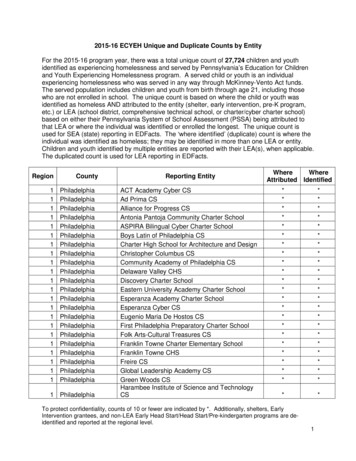
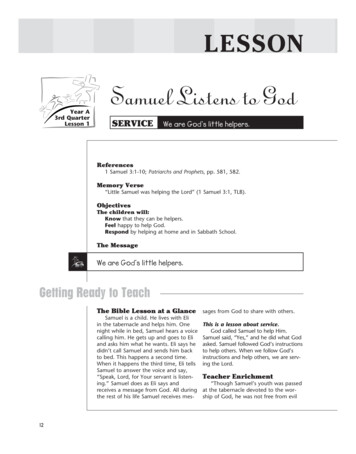


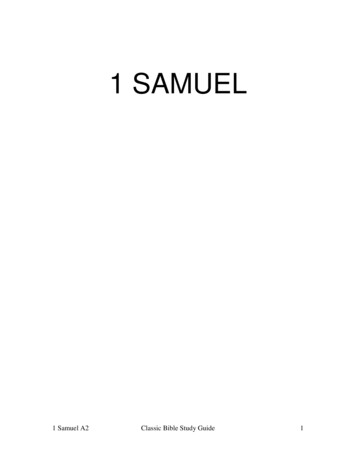
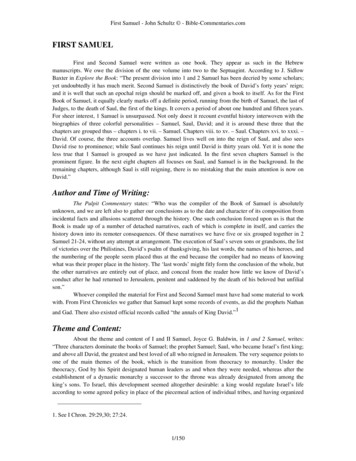
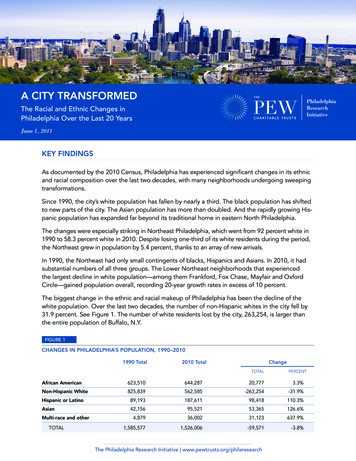
![Prekindergarten Head Start Application [Initial Screening]](/img/43/head-start-application.jpg)
